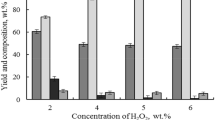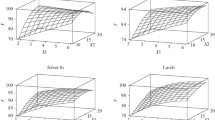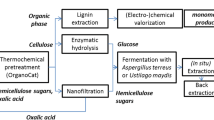Abstract
In this work, an organosolv process using beech wood as the feedstock, a mixture of water and methanol (50 vol%) as the solvent and aluminium chloride as the catalyst is designed. Different to other organosolv processes, the formation of the high value-added product furfural occurs already in the cooking stage with a quite high yield (40 mol% based on a lab scale literature process). Different to furfural producing processes, the cellulose remains in the solid phase in high quantity (93 wt% of the initial based on a lab scale literature process). The plant is designed in the way that 99.7 wt% of methanol is recovered. Another specification is the isolation of 95 wt% furfural with a purity of more than 99.5 wt%. After consecutive conversion of cellulose, the minimum sugar selling price of glucose as a dilute solution is calculated as 329 $/t depending strongly on the furfural yield as well as the application of lignin and the corresponding selling price.



Similar content being viewed by others
References
IEA. IEA bioenergy Task 42 on biorefineries (2007) Co-production of fuels, chemicals, power and materials from biomass. In: Minutes of the third Task meeting, Copenhagen, Denmark, 25–26
Bozell JJ, Petersen GR (2010) Technology development for the production of biobased products from biorefinery carbohydrates—the US Department of Energy’s “Top 10” revisited. Green Chem 12:539–554
Brownlee HJ, Miner CS (1923) Process of manufacturing furfural. UK Patent 203691-A
Nimlos MR, Qian X, Davis M, Himmel ME, Johnson DK (2006) Energetics of xylose decomposition as determined using quantum mechanics modeling. J Phys Chem A 110:11824–11838
Zeitsch KJ (2000) The chemistry and technology of furfural and its many byproducts, 1st edn. Elsevier, Amsterdam, pp 43–61
Cai CM, Zhang T, Kumar R, Wyman CE (2014) Integrated furfural production as a renewable fuel and chemical platform from lignocellulosic biomass. J Chem Technol Biotechnol 89:2–10
Alonso-Fagundez N, Granados ML, Mariscal R, Ojeda M (2012) Selective conversion of furfural to maleic anhydride and furan with VO(x)/Al(2)O(3) catalysts. ChemSusChem 5:1984–1990
Lecomte J, Finiels A, Geneste P, Moreau C (1998) Selective hydroxymethylation of furfuryl alcohol with aqueous formaldehyde in the presence of dealuminated mordernites. Appl Catal A 168:235–241
Hayes DJ, Fitzpatrick S, Hayes MHB, Ross JRH (2006) The biofine process—production of levulinic acid, furfural, and formic acid from lignocellulosic feedstocks. In: Kamm B, Gruber PR, Kamm M (eds) Biorefineries-industrial processes and products. Status quo and future directions, 1st edn. Wiley, Weinheim, pp 139–164
Van-Putten RJ, Van der Waal JC, De Jong E, Rasrendra CB, Heeres HJ, De Vries JG (2013) Hydroxymethylfurfural a versatile platform chemical made from renewable resources. Chem Rev 113:1499–1597
Frainier LJ, Fineberg H (1981) Preparation of furfuryl alcohol from furfural. US Patent 4302397
Timokhin BV, Baransky VA, Eliseeva GD (1999) Levulinic acid in organic synthesis. Russ Chem Rev 68:73–84
Mosier N, Wyman C, Dale B, Elander R, Lee YY, Holtzapple M, Ladisch M (2005) Features of promising technologies for pretreatment of lignocellulosic biomass. Bioresour Technol 96:673–686
Zheng Y, Pan Z, Zhang R (2009) Overview of biomass pretreatment for cellulosic ethanol production. Int J Agric Biol Eng 2:51–68
Tao L, Tan ECD, Aden A, Elander RT (2014) Techno-economic analysis and life-cycle assessment of lignocellulosic biomass to sugars using various pretreatment technologies. In: Sun J, Ding SY, Peterson JD (eds) Biological conversion of biomass for fuels and chemicals: exploration from natural utilization systems, 1st edn. RSC Publishing, Cambridge, pp 358–380
Mussatto SI, Dragone G, Guimaraes PMR, Paulo J, Silva A, Carneiro LM, Roberto IC, Vicente A, Domingues L, Teixeira JA (2010) Technological trends, global market, and challenges of bio-ethanol production. Biotechnol Adv 28:817–830
Van Haveren J, Scott EL, Sanders J (2008) Bulk chemicals from biomass. Biofuels Bioprod Bioref 2:41–57
Arato C, Pye EK, Gjennestad G (2005) The lignol approach to biorefining of woody biomass to produce ethanol and chemicals. Appl Biochem Biotechnol 123:871–882
Laure S, Leschinsky M, Fröhling M, Schultmann F, Unkelbach G (2014) Assessment of an organosolv lignocellulose biorefinary concept based on a material flow analysis of a pilot plant. Cellul Chem Technol 48:793–798
Gravitis J, Vedernikov N, Zandersons J, Kokerevics A (2001) Furfural and levoglucosan production from deciduous wood and agricultural wastes. In: Bozell JJ (ed) Chemicals and materials from renewable resources. American Chemical Society, Washington DC, pp 110–122
Vedernikov N, Kampars V, Puke M, Kruma I (2010) Changes in the birch wood lignocellulose composition in the pretreatment process. Sci J Riga TechUniv 22:68–72
Schwiderski M, Kruse A, Grandl R, Dockendorf D (2014) Comparison of the influence of a Lewis acid AlCl3 and a Brønsted acid HCl on the organosolv pulping of beech wood. Green Chem 16:1569–1578
Schwiderski M, Kruse A (2015) Catalytic effect of aluminium chloride on the example of the conversion of sugar model compounds. J Mol Catal A 402:64–70
Fernando EF, Vallejos EM, Area MC (2010) Lignin recovery from spent liquors from the ethanol-water fractionation of sugar cane bagasse. Cellul Chem Technol 44:311–318
Schwiderski M, Kruse A (2015) Aluminiumchlorid-katalysierter organosolv-aufschluss von buchenholz. Chem Ing Tech 87:922–930
AspenTech (2013) Aspen PlusTM V8.2. Software. Aspen Technology, Inc, Massachusetts
Kautto J, Realff MJ, Ragauskas AJ (2013) Design and simulation of an organosolv process for bioethanol production. Biomass Convers Bioref 3:199–212
Kautto J, Realff MJ, Ragauskas AJ, Kässi T (2014) Economic analysis of an organosolv process for bioethanol production. Bioresources 9:6041–6072
Eggeman T, Elander RT (2005) Process and economic analysis of pretreatment technologies. Bioresour Technol 96:2019–2025
Short W, Packey DJ, Holt T (1995) A manual for the economic evaluation and energy efficiency and renewable energy technologies. National Renewable Energy Laboratory technical report NREL/TP-462-5173 Colorado
Fogelholm C-J, Suutela J (1999) Heat and power co-generation. In: Gullichsen J, Fogelholm C-J (eds) Papermaking science and technology, chemical pulping, book 6B, 1st edn. Fapet Oy, Finland, pp 303–337
Demirbas A (2001) Relationships between lignin contents and heating values of biomass. Energy Convers Manage 42:183–188
Pittam DA, Pilcher G (1972) Measurements of heats of combustion by flame calorimetry. Part 8.—methane, ethane, propane, n-butane and 2-methylpropane. J Chem Soc Faraday Trans 1(68):2224–2229
Pan X, Xie D, Yu RW, Lam D, Saddler JN (2007) Pretreatment of lodgepole pine killed by mountain pine beetle using the ethanol organosolv process: fractionation and process optimization. Ind Eng Chem Res 46:2609–2617
Berguson B, Eaton J, Stanton B (2010) “Development of hybrid poplar for commercial production in the United States: the Pacific Northwest and Minnesota experience”, proceedings of the sustainable feedstocks for advanced fuels, sustainable alternative fuel feedstock opportunities, challenges and roadmaps for SIX U.S. regions, chapter 17, soil and water conservation society
ICIS indicative chemical prices. http://www.icis.com/chemicals/channel-info-chemicals-a-z. Accessed 02 July 2015
U.S. Energy Information Administration (2013) Natural gas weekly update. http://www.eia.gov/naturalgas/weekly/archive/2014/06_05/index.cfm. Accessed 15 April 2015
Humbird D, Davis R, Tao L, Kinchin C, Hsu D, Aden A, Schoen P, Lukas J, Olthof B, Worley M, Sexton D, Dudgeon D (2011) Process design and economics for biochemical conversion of lignocellulosic biomass to ethanol. National Renewable Energy Laboratory technical report NREL/TP-5100-47764. Colorado
U.S. Energy Information Administration (2013) Electricity wholesale market data. http://www.eia.gov/electricity/wholesale/index.cfm. Accessed 15 April 2015
Tin Win D (2005) Furfural - gold from garbage. AU J T 8:185–190
Watson LJ, Connors CG (2008) Furfural—a value adding opportunity for the Australian sugar industry. Proc Aust Soc Sugar Cane Technol 30:429–436
European Commission, Project of the Intake 2014 Sustainable Energy Services (2014) valorization of low concentration sugar-side stream from dissolving pulp production. http://www.exploreselect.eu/LinkClick.aspx?fileticket=mc5ZSusg5cE%3D&tabid=1421&language=en-GB. Accessed 20 June 2015
Pan X, Gilkes N, Kadla J, Pye K, Saka S, Gregg D, Ehara K, Xie D, Lam D, Saddler J (2006) Bioconversion of hybrid poplar to ethanol and co-products using an organosolv fractionation process: optimization of process yields. Biotechnol Bioeng 94:851–861
Rasrendra CB, Makertihartha IGBN, Adisasmito S, Heeres HJ (2010) Green chemicals from d-glucose: systematic studies on catalytic effects of inorganic salts on the chemo-selectivity and yield in aqueous solutions. Top Catal 53:1241–1247
Schwiderski M, Kruse A, Grandl R, Dockendorf D (2014) Kinetics of the AlCl3 catalyzed xylan hydrolysis during methanosolv pulping of beech wood. RSC Adv 4:45118–45127
Phillips S, Aden A, Jechura J, Dayton D, Eggeman T (2007) Thermochemical ethanol via indirect gasification and mixed alcohol synthesis of lignocellulosic biomass. National Renewable Energy Laboratory technical report NREL/TP-510-41168. Colorado
Gnansounou E, Dauriat A (2010) Techno-economic analysis of lignocellulosic ethanol: a review. Bioresour Technol 101:4980–4991
Huang HJ, Ramaswamy S, Al-Dajani W, Tschirner U, Cairncross RA (2009) Effect of biomass species and plant size on cellulosic ethanol: a comparative process and economic analysis. Biomass Bioenergy 33:234–246
Hu L, Pan H, Zhou Y, Zhang M (2011) Methods to improve lignin’s reactivity as a phenol substitute and as replacement for other phenolic compounds: a brief review. Bioresources 6:3515–3525
Chen MCW (2014) Commercial viability analysis of lignin based carbon fibre. Master thesis, Simon Fraser University
Mao L, Zhang L, Gao N, Li A (2013) Seawater-based furfural production via corncob hydrolysis catalyzed by FeCl3 in acetic acid steam. Green Chem 15:727–737
Zhang L, Yu H (2013) Conversion of xylan and xylose into furfural in biorenewable deep eutectic solvent with trivalent metal chloride added. Bioresources 8:6014–6025
Hallac BB, Sannigrahi P, Pu Y, Ray M, Murphy RJ, Ragauskas AJ (2010) Effect of ethanol organosolv pretreatment on enzymatic hydrolysis of buddleja davidii stem biomass. Ind Eng Chem Res 49:1467–1472
Brosse N, Sannigrahi P, Ragauskas A (2009) Pretreatment of miscanthus x giganteus using the ethanol organosolv process for ethanol production. Ind Eng Chem Res 48:8328–8334
McMillan JD (1993) Xylose fermentation to ethanol: a review. National Renewable Energy Laboratory technical report NREL/TP-421-4944. Colorado
Matsushika A, Inoue H, Kodaki T, Sawayama S (2009) Ethanol production from xylose in engineered saccharomyces cerevisiae strains: current state and perspectives. Appl Microbiol Biotechnol 84:37–53
Author information
Authors and Affiliations
Corresponding author
Electronic supplementary material
Below is the link to the electronic supplementary material.
ESM 1
(DOC 546 kb)
Rights and permissions
About this article
Cite this article
Schwiderski, M., Kruse, A. Process design and economics of an aluminium chloride catalysed organosolv process. Biomass Conv. Bioref. 6, 335–345 (2016). https://doi.org/10.1007/s13399-015-0189-z
Received:
Revised:
Accepted:
Published:
Issue Date:
DOI: https://doi.org/10.1007/s13399-015-0189-z




